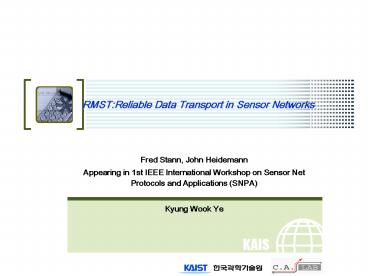RMST:Reliable Data Transport in Sensor Networks - PowerPoint PPT Presentation
1 / 16
Title:
RMST:Reliable Data Transport in Sensor Networks
Description:
Fred Stann, John Heidemann ... 3 /16. Introduction. Different constraints in sensor network. Energy constraints ... 11 /16. Analysis of Transport Layer Hop-by ... – PowerPoint PPT presentation
Number of Views:290
Avg rating:5.0/5.0
Title: RMST:Reliable Data Transport in Sensor Networks
1
RMSTReliable Data Transport in Sensor Networks
- Fred Stann, John Heidemann
- Appearing in 1st IEEE International Workshop on
Sensor Net Protocols and Applications (SNPA) - Kyung Wook Ye
2
Contents
- Introduction
- Architectural Choices
- RMST Architecture
- Analysis
- Analysis of MAC Layer Retries
- Analysis of Transport Layer Hop-by-Hop vs.
End-to-End - Evaluation of RMST
- Conclusion
3
Introduction
- Different constraints in sensor network
- Energy constraints
- Low wireless bandwidth
- Interoperability
- Considerations of reliability
- Mac layer
- Transport layer
- Application layer
4
Architectural Choices
- Mac Layer Design Choices
- No ARQ all transmissions are sent with a
randomized send time and a broadcast MAC address - ARQ always all transmissions are sent via a
stop-and-wait ARQ protocol with a single node
address - Seletive ARQ a combination of NO ARQ and ARQ
- Transport Layer Design Choices
- End-to-End Selective Request NACK
- The need for repair and the generation of repair
requests takes place only at sinks. - Hop-by-Hop Selective Request NACK and Repair from
Cache - Each caching node caches the fragments.
5
Architectural Choices
- Application Layer Design Choices
- End-to-End Positive ACK
- A sink requests to receive a large data entity
- When all fragments have arrived at the sink it
deletes its request. - Sources send the entire set of fragments at
precalculated intervals until request is deleted.
6
RMST Architecture
- RMST Overview
- The RMST Protocol
- Was implemented as a filter without recompilation
of the diffusion - core or Gradient filter
- Has caching mode, non-caching mode
- A unique RMST entity
- Is a data set consisting of one or more fragments
coming from the same source. - Responsibility of fragmentation/reassembly and
guaranteed delivery - When a node fails
- The normal behavior of Diffusion is to
re-establish a new set of data gradients.
7
RMST Architecture
- RMST Basic Services
- To support reliable traffic
- RmstNo, FragNo, MaxFrag
- RMST Support for Loss Detection and Repair
- In non-caching mode
- Only sinks set timers to detect loss
- In caching mode
- Each caching node on the reinforced path from
source to sink detects loss - The back-channel
- In order to deliver NAKs to upstream neighbors.
- Node Failure
- In case of node failure
- A new reinforced path will be established by
diffusion.
8
RMST Architecture
- Support for Caching
- In caching mode
- A node maintains a local cache of traffic in
progress or recently transmitted. - In non-caching mode
- Only the sources and sinks maintain a cache.
9
Analysis of MAC Layer Retries
- The Probability of success with MAC-level ARQ
- The Probability of not failing at all R tries
- End-to-End Probability of arrival
10
Analysis of MAC Layer Retries
- Number of MAC-level retries and Probability
11
Analysis of Transport Layer Hop-by-Hop vs.
End-to-End
- Number of transmissions Hop-by-hop vs End-to-End
repair
12
Evaluation of RMST
- Environment
- Ns-2
- Mac 802.11
- Hop count 6 hops
- The number of retries 4
- Size of blob 5k
13
Evaluation of RMST
- Baseline End-to-End Positive ACK
14
Evaluation of RMST
- RMST with Hop-by-Hop Recovery and Caching
15
Evaluation of RMST
- RMST with End-to-End Recovery
16
Conclusion
- The best implementation for reliability in
distributed sensor network architectures involves
both the transport and MAC layers. - It is beneficial to employ MAC level ARQ for
control and data packets that are unicast on the
paths selected for data transfer - Route discovery packets should be broadcast
without any MAC layer reliability mechanism. - RMST constitutes a good basis for expanding the
application domain of directed diffusion into
areas requiring guaranteed






![ESRT: Event-to-Sink Reliable Transport in Wireless Sensor Networks[Sankarasubramaniam et. al, ACM MobiHoc 2003] PowerPoint PPT Presentation](https://s3.amazonaws.com/images.powershow.com/6075243.th0.jpg?_=20201118051)
























